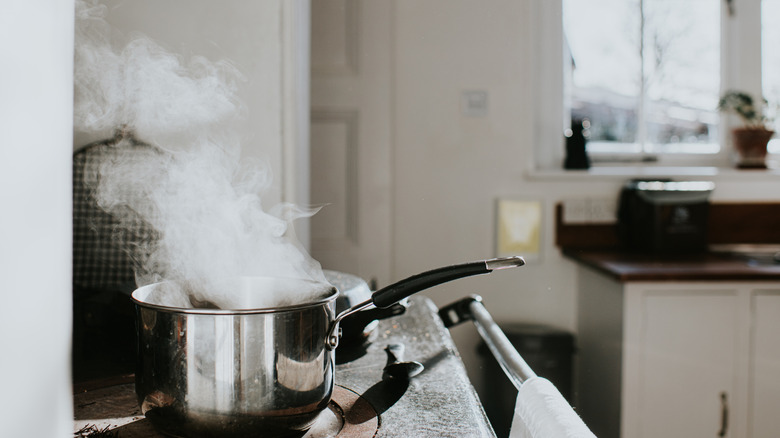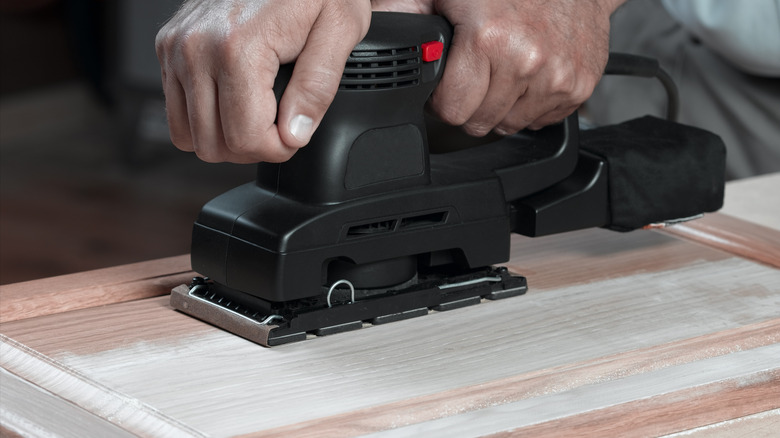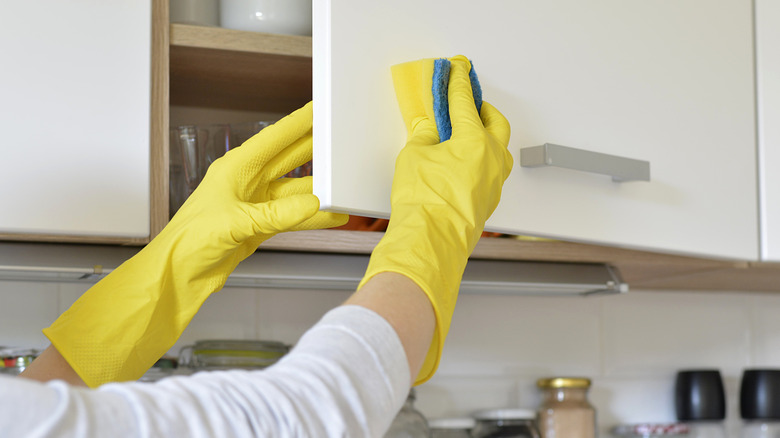The Best Way To Fix Steam Damage On Kitchen Cabinets (And Tips For Preventing It)
We may receive a commission on purchases made from links.
You're in the kitchen preparing a meal only to notice stains or a strange texture starting to appear on your cabinets. It's only natural to rack your brain for a cause, but the culprit may be something you least expect: steam damage. Steam is an everyday occurrence in the kitchen that can be produced from normal tasks like a dishwasher cycle or just preparing a meal. You may not think anything of steam rising and passing over your cabinets, but there are risks to letting this happen with no intervention over time. One of the best ways to combat steam damage is to first clean the surface before sanding and repainting the cabinets. However, the precise method will depend on how severe the damage is.
If you're unfamiliar with steam damage, it can be hard to identify if that's what is causing issues with your cabinets. One of the main signs of steam starting to affect cabinets is minor staining or discoloration on the surface. The specific type of stain that's caused by steam and heat damage is often a pale white color with a milky appearance. Additional signs of steam damage you might notice include the surface starting to warp or take on a strange, bumpy texture, as well as the actual cabinets starting to peel, separate, or even turn soft and degrade away. Regardless of the damage, you can remedy the problem and breathe new life into your cabinets.
The best way to reverse steam damage on kitchen cabinets
Before diving into this cabinet cleaning and restoration project, you'll need to assess the level of damage to the material. For example, if you're dealing with some surface stains, you'll more than likely be able to clean the cabinets. In these instances, you'll want to start by cleaning and degreasing the cabinets with a mixture of water and dish soap to remove any staining. Be sure not to get the cabinet too wet. After this, use a clean cloth to dab a tiny amount of coconut oil onto any white, discolored areas. Rub the oil into the spots and allow it to absorb fully to reverse the stain damage.
For more extensive cabinet damage like peeling or a bumpy texture, you'll need to sand down the affected areas after cleaning away any surface grime. You do this by using a handheld sander or a sanding block with medium grit or roughly 100-grit paper. Work in small sections and sand along the wood grain's natural direction for the best results. Next, if necessary, use a product like Gorilla All Purpose Wood Filler to repair any damage like cracks or chips and then lightly sand again until smooth. This is the majority of the restoration process, and all that remains is to customize the cabinets with your choice of paint or stain. This is also a great time to touch up on the existing colors or determine the best new color for your kitchen cabinets.
Helpful tips to prevent steam damage to kitchen cabinets
Whether you've just finished fixing steam damage to your kitchen cabinets or just want to keep yours in tip-top shape, preventing and staying ahead of the damage is the key. First, it's important to learn how to clean and degrease kitchen cabinets regularly. This will minimize grease and buildup that can lead to staining. It may also be helpful to use your stove's exhaust fan or open a window to help ventilate the room while cooking. If space isn't an issue, you can consider rearranging your kitchen's layout to keep steam-making appliances away from being directly under cabinetry.
Another solution that requires a bit more elbow grease is to add a protective waterproof coating to the cabinets. There are many different waterproofing options available, ranging from sealants and paint to varnishes. Each has its own specific uses, and the best for your kitchen will come down to personal preference and goals. However, as a whole, these types of products essentially create a barrier between the cabinets and any excess moisture to prevent it from seeping into the wood and causing damage. No matter how you choose to remedy your steam-damaged cabinets, prevention afterward is important to protecting them long term.


